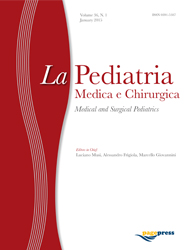Articles
31 August 2013
Vol. 35 No. 4 (2013)
A not very essential obesity: the Rohhad Syndrome. Description of two cases and review of the literature
Publisher's note
All claims expressed in this article are solely those of the authors and do not necessarily represent those of their affiliated organizations, or those of the publisher, the editors and the reviewers. Any product that may be evaluated in this article or claim that may be made by its manufacturer is not guaranteed or endorsed by the publisher.
All claims expressed in this article are solely those of the authors and do not necessarily represent those of their affiliated organizations, or those of the publisher, the editors and the reviewers. Any product that may be evaluated in this article or claim that may be made by its manufacturer is not guaranteed or endorsed by the publisher.
2114
Views
5398
Downloads
Authors
Dipartimento di Scienze Pediatriche Ginecologiche Microbiologiche e Biomediche, Università di Messina, Messina, Italy.
Dipartimento di Scienze Pediatriche Ginecologiche Microbiologiche e Biomediche, Università di Messina, Messina, Italy.
Dipartimento di Scienze Pediatriche Ginecologiche Microbiologiche e Biomediche, Università di Messina, Messina, Italy.
Dipartimento di Scienze Pediatriche Ginecologiche Microbiologiche e Biomediche, Università di Messina, Messina, Italy.
Dipartimento di Scienze Pediatriche Ginecologiche Microbiologiche e Biomediche, Università di Messina, Messina, Italy.
Dipartimento di Scienze Pediatriche Ginecologiche Microbiologiche e Biomediche, Università di Messina, Messina, Italy.
Dipartimento di Scienze Pediatriche Ginecologiche Microbiologiche e Biomediche, Università di Messina, Messina, Italy.
Dipartimento di Scienze Pediatriche Ginecologiche Microbiologiche e Biomediche, Università di Messina, Messina, Italy.
How to Cite
A not very essential obesity: the Rohhad Syndrome. Description of two cases and review of the literature. (2013). La Pediatria Medica E Chirurgica, 35(4). https://doi.org/10.4081/pmc.2013.40
PAGEPress has chosen to apply the Creative Commons Attribution NonCommercial 4.0 International License (CC BY-NC 4.0) to all manuscripts to be published.









